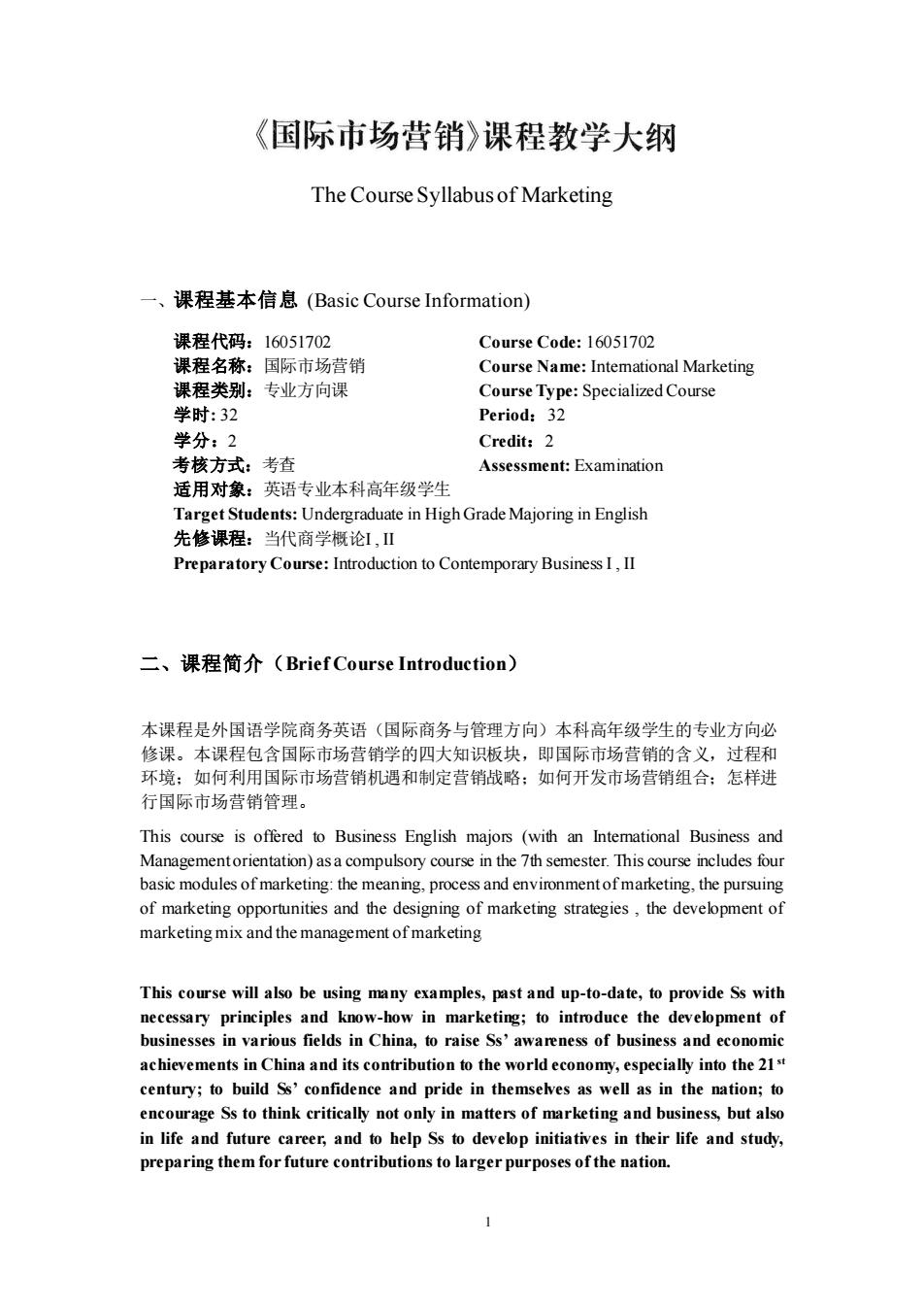
《国际市场营销》课程教学大纲 The Course Syllabus of Marketing 一、课程基本信息(Basic Course Information) 课程代码:16051702 Course Code:16051702 课程名称:国际市场营销 Course Name:Intemational Marketing 课程类别:专业方向课 Course Type:Specialized Course 学时:32 Period:32 学分:2 Credit:2 考核方式:考查 Assessment:Examination 适用对象:英语专业本科高年级学生 Preparatory Course:Introduction to Contemporary BusinessI,II 二、课程简介(BriefCourse Introduction) 本课程是外国语学院商务英语(国际商务与管理方向)本科高年级学生的专业方向必 修课。本课程包含国际市场营销学的四大知识板块,即国际市场营销的含义,过程和 环境:如何利用国际市场营销机遇和制定营销战略:如何开发市场营销组合:怎样进 行国际市场营销管理。 This course is offered to Business English majors (with an Inte ational Business s and Ma agementori nta basic modules of marketing:the meanng proceand environment of marketing,the pursuing of marketing opportunities and the designing of marketing strategies,the development of marketing mix and the management of marketing This course will also be sing many examples,past and up-to-date,to provide Ss with necessary principles and know-how in marketing;to introduce the development of businesses in various fields in China,to raise Ss'awareness of business and economic achievements in China and its contribution to the world economy,especially into the 21" century;to build Ss'confidence and pride in themselves as well as in the nation:to in life and future career,and to help Ss to develop initiatives in their life and study. preparing them for future contributions to larger purposes of the nation. 1
1 The Course Syllabus of Marketing 一、课程基本信息 (Basic Course Information) 课程代码:16051702 Course Code: 16051702 课程名称:国际市场营销 Course Name: International Marketing 课程类别:专业方向课 Course Type: Specialized Course 学时: 32 Period:32 学分:2 Credit:2 考核方式:考查 Assessment: Examination 适用对象:英语专业本科高年级学生 Target Students: Undergraduate in High Grade Majoring in English 先修课程:当代商学概论I , II Preparatory Course: Introduction to Contemporary Business I , II 二、课程简介(Brief Course Introduction) 本课程是外国语学院商务英语(国际商务与管理方向)本科高年级学生的专业方向必 修课。本课程包含国际市场营销学的四大知识板块,即国际市场营销的含义,过程和 环境;如何利用国际市场营销机遇和制定营销战略;如何开发市场营销组合;怎样进 行国际市场营销管理。 This course is offered to Business English majors (with an International Business and Management orientation) as a compulsory course in the 7th semester. This course includes four basic modules of marketing: the meaning, process and environment of marketing, the pursuing of marketing opportunities and the designing of marketing strategies , the development of marketing mix and the management of marketing This course will also be using many examples, past and up-to-date, to provide Ss with necessary principles and know-how in marketing; to introduce the development of businesses in various fields in China, to raise Ss’ awareness of business and economic achievements in China and its contribution to the world economy, especially into the 21st century; to build Ss’ confidence and pride in themselves as well as in the nation; to encourage Ss to think critically not only in matters of marketing and business, but also in life and future career, and to help Ss to develop initiatives in their life and study, preparing them for future contributions to larger purposes of the nation
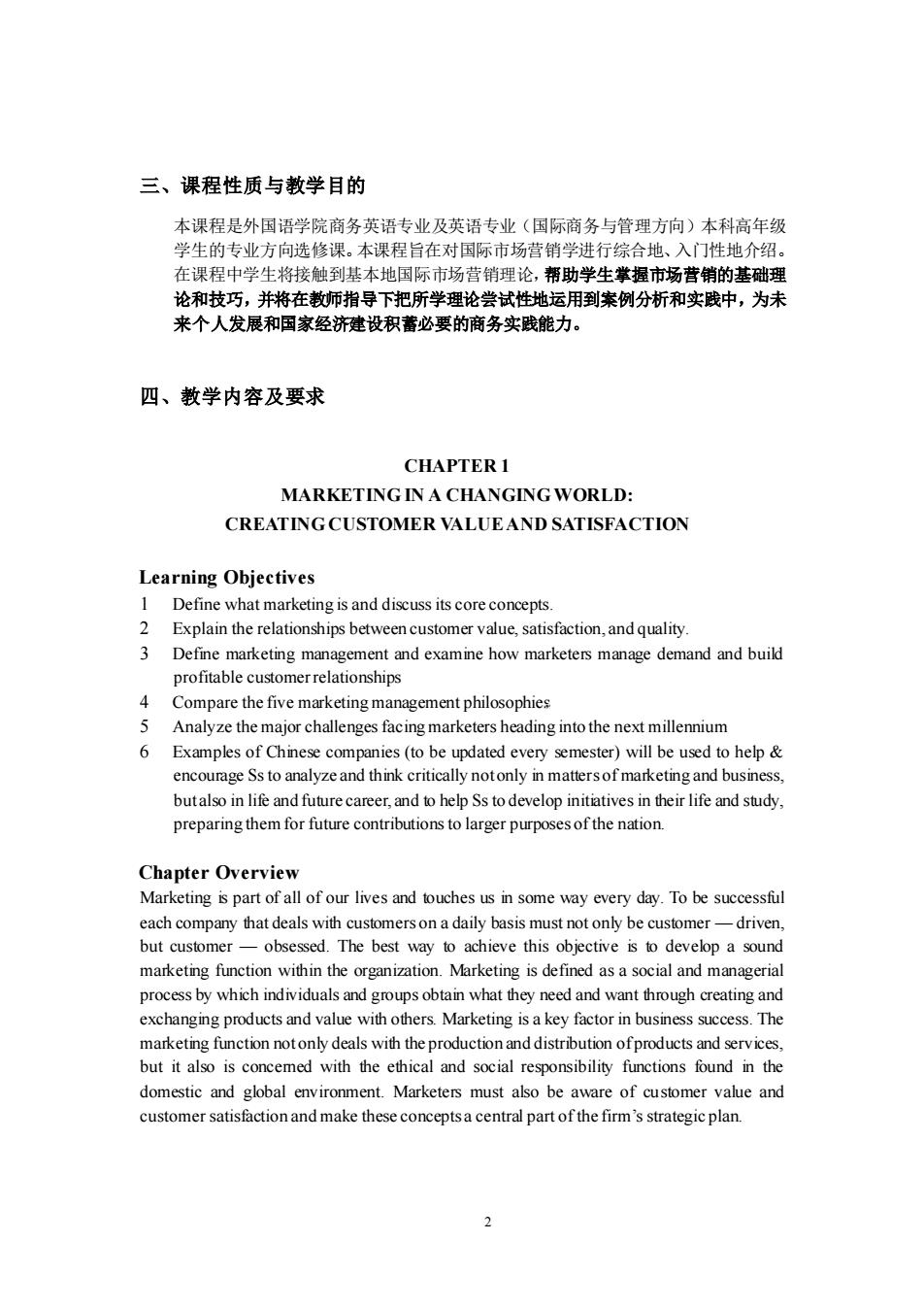
三、课程性质与教学目的 本课程是外国语学院商务英语专业及英语专业(国际商务与管理方向)本科高年级 学生的专业方向选修课。本课程旨在对国际市场营销学进行综合地、入门性地介绍 在课程中学生将接触到基本地国际市场营销理论,帮助学生举握市场营销的基础理 论和技巧,并将在教师指导下把所学理论尝试性地运用到案例分析和实贱中,为未 来个人发履和国家经济建设积蕾必要的商务实践能力。 四、教学内容及要求 CHAPTERI MARKETING IN A CHANGING WORLD: CREATING CUSTOMER VALUEAND SATISFACTION Learning Objectives 1 Define what marketing is and discuss its core concepts 2 Define marketing management and examine how marketers manage demand and buil profitable customer relationships 4 Compare the five marketing management philosophies Analye the major challenges facing marketers heading into the next 6 Examples of Chinese companies(to be updated every semester)will be used to help& encourage Ss to analyze and think critically notonly in matters of marketing and business. butalso in life and future career,and to help Ss to develop initiatives in their life and study. preparing them for future contributions to larger purposesof the nation. Chapter Overview Marketing is part of all of our lives and touches us in some way every day.To be successful each company that deals with customers on a daily basis must not only be customer-driven but customer-obsessed.The best way to achieve this obiective is to develop a sound marketing functi within the organition.Marketing is defined as a social and managerial process by which individuals and groups obtain what they need and wanth ough creating an exchanging products and value with others.Marketing is a key factor in business success.The marketing function notonly deals with the production and distribution ofproducts and services but it also is concemed with the ethical and social responsibility functions found in the domestic and glbal environment.Marketers must akso be aware of customer value and customer satisfactionand make these conceptsa central part of the firm's strategic pla
2 三、课程性质与教学目的 本课程是外国语学院商务英语专业及英语专业(国际商务与管理方向)本科高年级 学生的专业方向选修课。本课程旨在对国际市场营销学进行综合地、入门性地介绍。 在课程中学生将接触到基本地国际市场营销理论,帮助学生掌握市场营销的基础理 论和技巧,并将在教师指导下把所学理论尝试性地运用到案例分析和实践中,为未 来个人发展和国家经济建设积蓄必要的商务实践能力。 四、教学内容及要求 CHAPTER 1 MARKETING IN A CHANGING WORLD: CREATING CUSTOMER VALUE AND SATISFACTION Learning Objectives 1 Define what marketing is and discuss its core concepts. 2 Explain the relationships between customer value, satisfaction, and quality. 3 Define marketing management and examine how marketers manage demand and build profitable customer relationships 4 Compare the five marketing management philosophies 5 Analyze the major challenges facing marketers heading into the next millennium 6 Examples of Chinese companies (to be updated every semester) will be used to help & encourage Ss to analyze and think critically not only in matters of marketing and business, but also in life and future career, and to help Ss to develop initiatives in their life and study, preparing them for future contributions to larger purposes of the nation. Chapter Overview Marketing is part of all of our lives and touches us in some way every day. To be successful each company that deals with customers on a daily basis must not only be customer — driven, but customer — obsessed. The best way to achieve this objective is to develop a sound marketing function within the organization. Marketing is defined as a social and managerial process by which individuals and groups obtain what they need and want through creating and exchanging products and value with others. Marketing is a key factor in business success. The marketing function not only deals with the production and distribution of products and services, but it also is concerned with the ethical and social responsibility functions found in the domestic and global environment. Marketers must also be aware of customer value and customer satisfaction and make these concepts a central part of the firm’s strategic plan

Marketing must also be aware ofand respond to change.Four of the greatest changes that have the computer,the Intemet telecommunications,and infommation technology.Marketing and it core concepts,the exchange relationship,the major philosophies of marketing thought and practice,and marketing challenges in the new connected'millennium are the major topics presented in this introductory chapter.There is a special emphasis on connected and the echnologies for accomplishing connections Home Assignments Review the issues listed in the learningobjectives. Teaching Methods Lecturing.presentation,discussion,teamwork and case study with the aid of different media CHAPTER2 STRATEGIC PLANNINGAND THE MARKETING PROCESS Learning Objectives 1 Explain company-wide strategic planningand its four steps Discuss how to design business portfolios and growth strategies 3 Explain functional planning strategies and assess marketing's role in strategic planning 4 Describe the marketing process and the forces that influence it. 5 6 Examples of Chinese companies(to be updated every semester)will be used to help& encourage Ss to analyze and think critically notonly in matters of marketing and business. butalso in life and future career,and to help Ss to develop initiatives in their life and study. oreparing them for future contributions to larger purposes of the nation. Chapter Overview To meet changing conditions in their industries.companies need to look ahead and develop long-term strategies.Strategc planning involves develop ing a strategy to meet insure lo ng-t and The marketing function plays ar important ole in this process in that it provides information and other inputs to help in the preparation of th organization s strategic plan. Strategic planning is described as the process of developing and maintaining a strategic fit between the organization s goals and capabilities and its changing marketing opportunities. Strategic planning sets the stage for the rest of the planning in the firm 3
3 Marketing must also be aware of and respond to change. Four of the greatest changes that have had an impact on the way companies bring value to their customers are the explosive growth of the computer, the Internet, telecommunications, and information technology. Marketing and its core concepts, the exchange relationship, the major philosophies of marketing thought and practice, and marketing challenges in the new connected ' millennium are the major topics presented in this introductory chapter. There is a special emphasis on connected and the technologies for accomplishing connections. Home Assignments Review the issues listed in the learning objectives. Teaching Methods Lecturing, presentation, discussion, teamwork and case study with the aid of different media CHAPTER 2 STRATEGIC PLANNING AND THE MARKETING PROCESS Learning Objectives 1 Explain company-wide strategic planning and its four steps. 2 Discuss how to design business portfolios and growth strategies. 3 Explain functional planning strategies and assess marketing’s role in strategic planning. 4 Describe the marketing process and the forces that influence it. 5 List the marketing management functions, including the elements of a marketing plan. 6 Examples of Chinese companies (to be updated every semester) will be used to help & encourage Ss to analyze and think critically not only in matters of marketing and business, but also in life and future career, and to help Ss to develop initiatives in their life and study, preparing them for future contributions to larger purposes of the nation. Chapter Overview To meet changing conditions in their industries, companies need to look ahead and develop long-term strategies. Strategic planning involves developing a strategy to meet competition and insure long-term survival and growth. The marketing function plays an important role in this process in that it provides information and other inputs to help in the preparation of the organization s strategic plan. Strategic planning is described as the process of developing and maintaining a strategic fit between the organization s goals and capabilities and its changing marketing opportunities. Strategic planning sets the stage for the rest of the planning in the firm
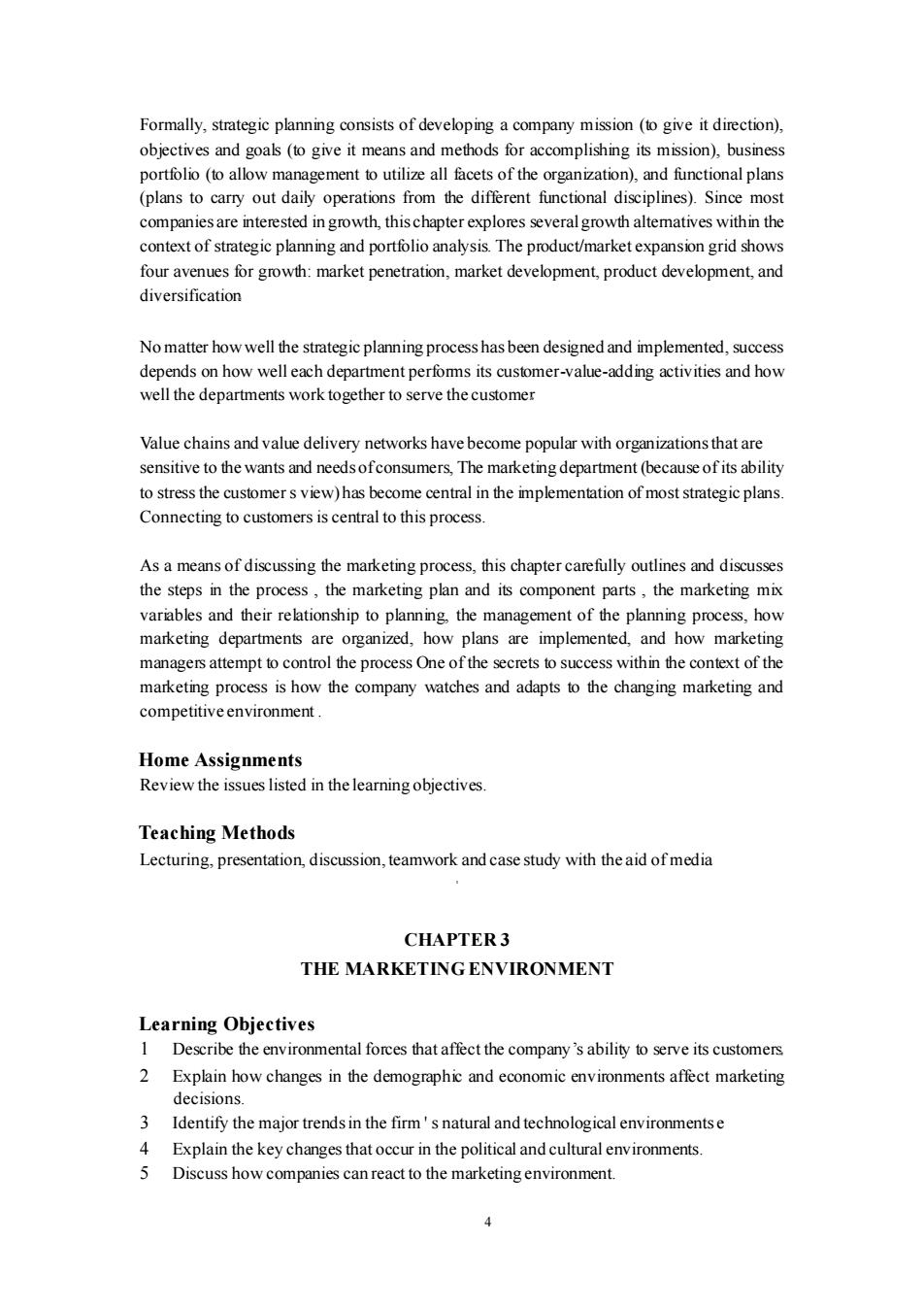
Formally,strategic planning consists of developing a company mission (to give it direction). nagement to utilize all facets of the (plans to carry out daily operations from the different fiunctional disciplines).Since mos companies are interested in growth,thischapter explores severalgrowth altematives within the context of strategic planning and portfolio analysis The product/market expansion grid shows No matter how well the strategic planning process has been designed and implemented.success Value chains and value delivery networks have become popular with organizations that are sensitive to the wants and needsofconsumers,The marketing department(because of its ability tostress the)has become central nhe implementation of most strategic plans. Connecting to customers is central to this process As a means of discussing the marketing process,this chapter carefully outlines and discusses the steps in the process,the marketing plan and its component parts,the marketing mix variables and their relationship to planning the management of the planning marketing departments implemer managers attempt to control the process One of the secrets to success within the context of th marketing process is how the company watches and adapts to the changing marketing and competitive environment Home Assignme Review the issues listed in the learningobjectives Teaching Methods Lecturing.presentation,discussion,teamwork and case study with theaid of media CHAPTER3 THE MARKETING ENVIRONMENT Learning Objectives Describe the environmental forces that affect the company's ability to serve its customers Explain how changes in the demographic and economic environments affect marketing decisions. 3 Identify the major trends in the firm's natural and technological environmentse Explain the key changes the political Discuss how companies can react to the marketing environmen 4
4 Formally, strategic planning consists of developing a company mission (to give it direction), objectives and goals (to give it means and methods for accomplishing its mission), business portfolio (to allow management to utilize all facets of the organization), and functional plans (plans to carry out daily operations from the different functional disciplines). Since most companies are interested in growth, this chapter explores several growth alternatives within the context of strategic planning and portfolio analysis. The product/market expansion grid shows four avenues for growth: market penetration, market development, product development, and diversification No matter how well the strategic planning process has been designed and implemented, success depends on how well each department performs its customer-value-adding activities and how well the departments work together to serve the customer Value chains and value delivery networks have become popular with organizations that are sensitive to the wants and needs of consumers, The marketing department (because of its ability to stress the customer s view) has become central in the implementation of most strategic plans. Connecting to customers is central to this process. As a means of discussing the marketing process, this chapter carefully outlines and discusses the steps in the process , the marketing plan and its component parts , the marketing mix variables and their relationship to planning, the management of the planning process, how marketing departments are organized, how plans are implemented, and how marketing managers attempt to control the process One of the secrets to success within the context of the marketing process is how the company watches and adapts to the changing marketing and competitive environment . Home Assignments Review the issues listed in the learning objectives. Teaching Methods Lecturing, presentation, discussion, teamwork and case study with the aid of media CHAPTER 3 THE MARKETING ENVIRONMENT Learning Objectives 1 Describe the environmental forces that affect the company’s ability to serve its customers 2 Explain how changes in the demographic and economic environments affect marketing decisions. 3 Identify the major trends in the firm ' s natural and technological environments e 4 Explain the key changes that occur in the political and cultural environments. 5 Discuss how companies can react to the marketing environment
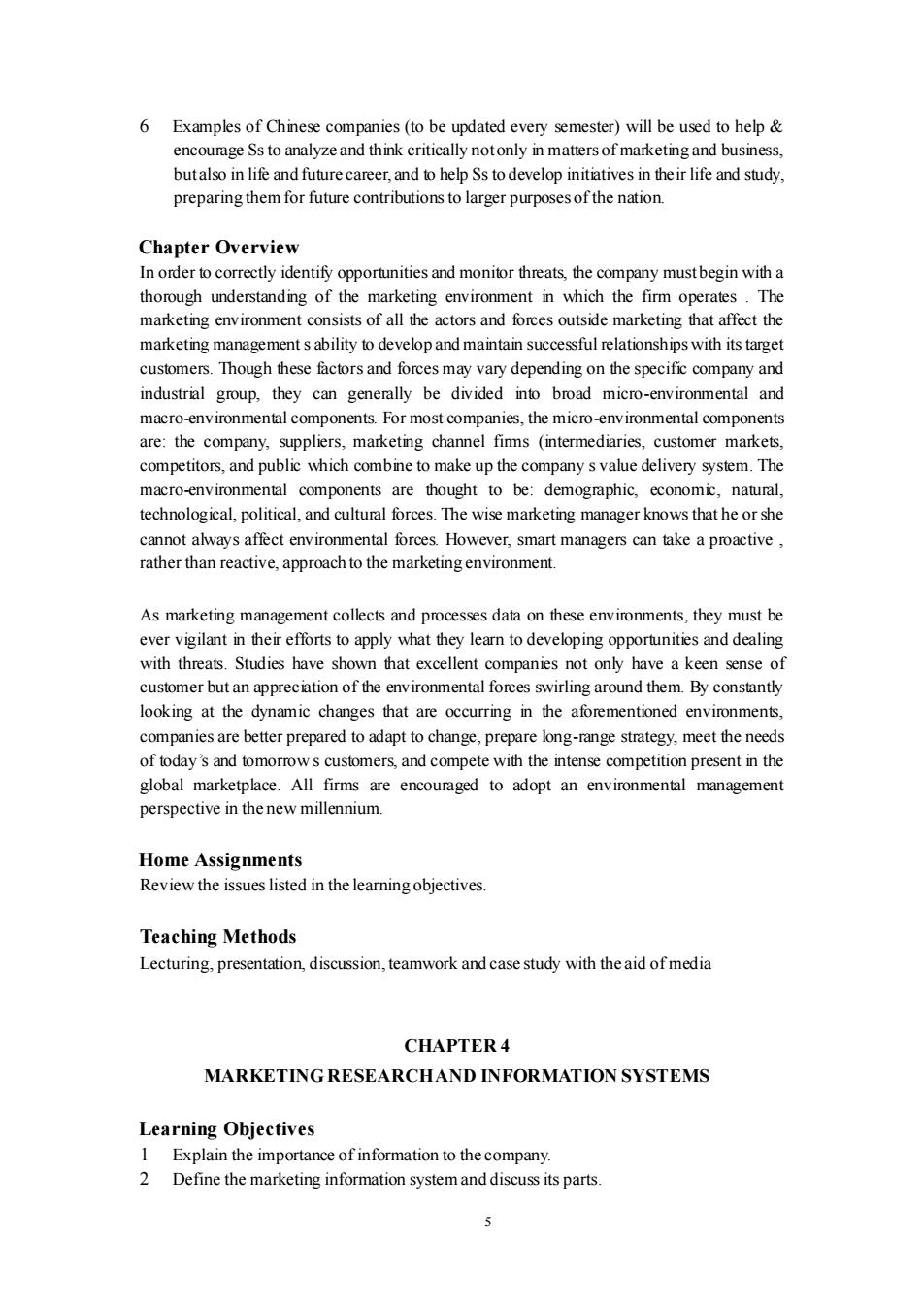
6 Examples of Chinese comp nies(to be updated every semester)will be used to help encourage to analyze and think butalso in life and future career,and to help Ss to develop initiatives in the ir life and study. preparing them for future contributions to larger purposes of the nation. Chapter Overview mon reats he company mustbegin with a thorough understanding of the marketing environment in which the firm operates marketing environment consists of all the actors and forces outside marketing that affect the marketing management s ability to develop and maintain successful relationships with its target customers.Though these factors and forces may vary depending on the specific company and industrial group.they can generally be divided ino broad micr and macro-environmental components.For most companies,the micro- environmental components are:the company,suppliers.marketing channel fims (intermediaries,customer markets. competitors,and public which combine to make up the company s value delivery system.The macro-environmental components are thought to be:demographic.economic,natural. technological,political,and cultural forces.The wise marketing m nager knows that he or she cannot always affect environmental forces.However,smart managers can take a proactive. rather than reactive,approach to the marketing environment As marketin ent collects and proc s data on these environments,they must be ever vigilant in heir efforts to apply what they leam to developing opporunities and dealing with threats.Studies have shown that excellent companies not only have a keen sense of customer but an appreciation of the environmental forces swirling around them.By constantly looking at the dynamic changes that are occurring in the aforementioned environments. nies are better prepared to adapt to change.pre are long-range strategy,meet the needs ofoyad tomos cutmerand empete the eomp n present in the global marketplace.All firms are encouraged to adopt an environmental management perspective in the new millennium. Home Assignme Review the issues listed in the learning objectives Teaching Methods Lecturing,presentation,discussion,teamwork and case study with theaid of media CHAPTER4 MARKETING RESEARCHAND INFORMATION SYSTEMS Learning Objectives 1 Explain the importance of information to the company 2 Define the marketing information systemand discuss its parts 5
5 6 Examples of Chinese companies (to be updated every semester) will be used to help & encourage Ss to analyze and think critically not only in matters of marketing and business, but also in life and future career, and to help Ss to develop initiatives in their life and study, preparing them for future contributions to larger purposes of the nation. Chapter Overview In order to correctly identify opportunities and monitor threats, the company must begin with a thorough understanding of the marketing environment in which the firm operates . The marketing environment consists of all the actors and forces outside marketing that affect the marketing management s ability to develop and maintain successful relationships with its target customers. Though these factors and forces may vary depending on the specific company and industrial group, they can generally be divided into broad micro-environmental and macro-environmental components. For most companies, the micro-environmental components are: the company, suppliers, marketing channel firms (intermediaries, customer markets, competitors, and public which combine to make up the company s value delivery system. The macro-environmental components are thought to be: demographic, economic, natural, technological, political, and cultural forces. The wise marketing manager knows that he or she cannot always affect environmental forces. However, smart managers can take a proactive , rather than reactive, approach to the marketing environment. As marketing management collects and processes data on these environments, they must be ever vigilant in their efforts to apply what they learn to developing opportunities and dealing with threats. Studies have shown that excellent companies not only have a keen sense of customer but an appreciation of the environmental forces swirling around them. By constantly looking at the dynamic changes that are occurring in the aforementioned environments, companies are better prepared to adapt to change, prepare long-range strategy, meet the needs of today’s and tomorrow s customers, and compete with the intense competition present in the global marketplace. All firms are encouraged to adopt an environmental management perspective in the new millennium. Home Assignments Review the issues listed in the learning objectives. Teaching Methods Lecturing, presentation, discussion, teamwork and case study with the aid of media CHAPTER 4 MARKETING RESEARCH AND INFORMATION SYSTEMS Learning Objectives 1 Explain the importance of information to the company. 2 Define the marketing information system and discuss its parts
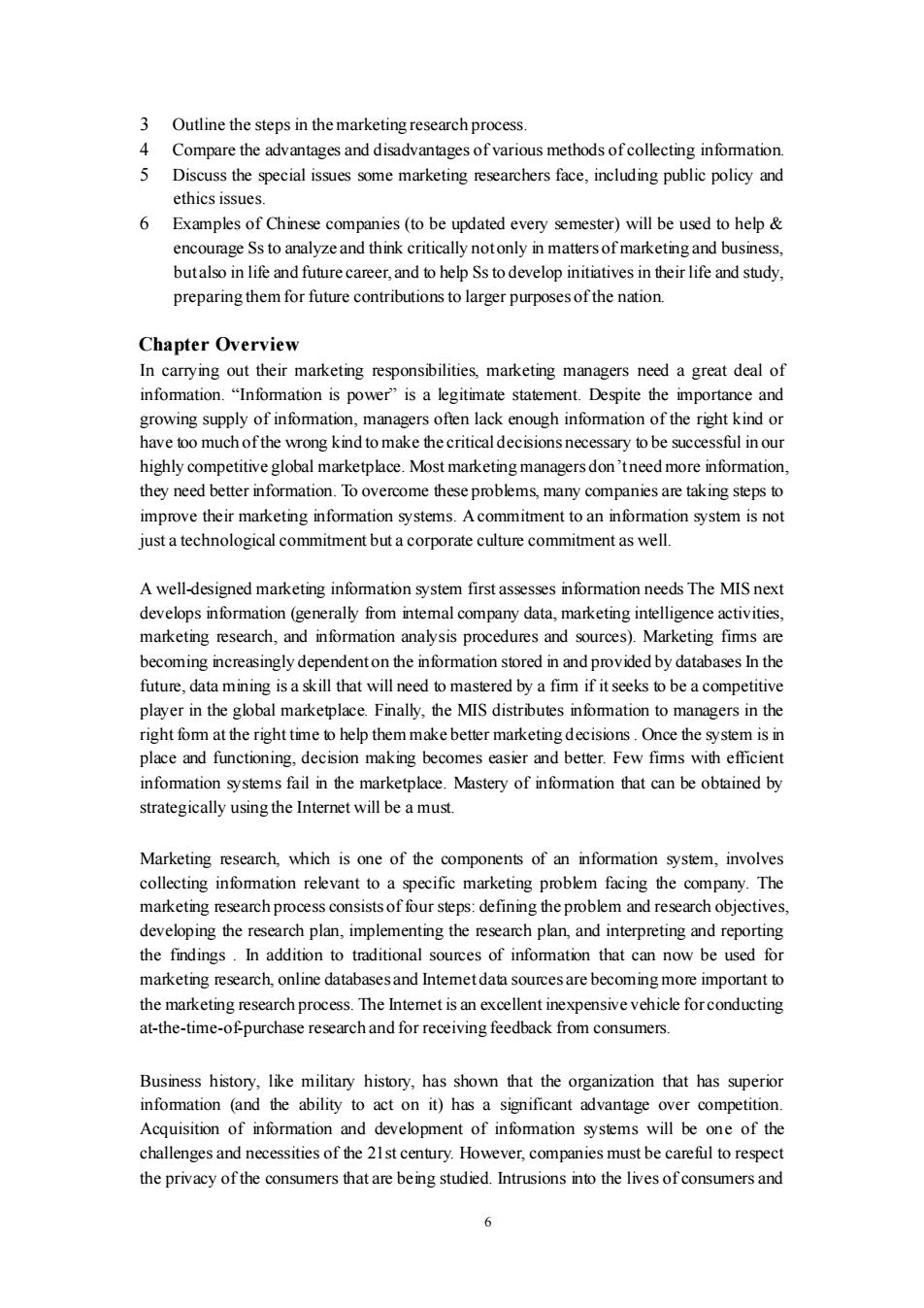
3 Outline the steps in the marketingresearch process. 4 Compare the advantages and disadvantages of various methods of collecting infommatio 5 Discuss the special issues some marketing searchers face,including public policy and ethics issues. 6 Examples of Chinese companies (to be updated every semester)will be used to help& butalso futur preparing them for future contributions to larger purposesof the nation Chapter Overview In carrying out their marketing responsibilities marketing managers need a great deal of infomation.in s power is a gitimate statemen ite the mport e and have too much of the wrong kind to make the critical decisions necessary to be successful in our highly competitive global marketplace.Most marketing managers don'tneed more information, they need better information.To overcome these problems,many companies are taking steps to not A well-designed marketing infommation system first assesses information needs The MIS next develops information (generally from intemal company data.marketing intelligence activities marketing research,and information analysis procedures and sources).Marketing fims are future,data mining is a skill that will need to mastered by a fim if it seeks to be a competitive plaver in the global marketplace.Finally.the MIS distributes infommation to managers in the right fom at the right time to help them make better marketing decisions.Once the system is in place and functioning.decision making becomes casier and better.Few fims with efficient nfomation ystems fail in he marketplace.Mastery of that can be obtined by strategically using the Internet will be a must. Marketing research,which is one of the compo nts of an information system,involves ation relevant to pecific marke facing the e company The marketing research process consistsof four steps:defining the problem and research objectives developing the research plan,implementing the research plan,and interpreting and reporting the findings.In addition to traditional sources of information that can now be used for marketing research.online databasesand Intemet data sources are becoming more important to the.The ntemet forconducting at-the-time-ofpurchase rearch and for receiving feedback from consumers Business history.like military history.has shown that the organization that has sup ion (an d the ability to on it)has significant advantage competi Acquisition of information and development of infomation systems will be one of the challenges and necessities of the 21st century.However,companies must be careful to respect the privacy of the consumers that are being studied.Intrusions into the lives of consumers and 6
6 3 Outline the steps in the marketing research process. 4 Compare the advantages and disadvantages of various methods of collecting information. 5 Discuss the special issues some marketing researchers face, including public policy and ethics issues. 6 Examples of Chinese companies (to be updated every semester) will be used to help & encourage Ss to analyze and think critically not only in matters of marketing and business, but also in life and future career, and to help Ss to develop initiatives in their life and study, preparing them for future contributions to larger purposes of the nation. Chapter Overview In carrying out their marketing responsibilities, marketing managers need a great deal of information. “Information is power” is a legitimate statement. Despite the importance and growing supply of information, managers often lack enough information of the right kind or have too much of the wrong kind to make the critical decisions necessary to be successful in our highly competitive global marketplace. Most marketing managers don’t need more information, they need better information. To overcome these problems, many companies are taking steps to improve their marketing information systems. A commitment to an information system is not just a technological commitment but a corporate culture commitment as well. A well-designed marketing information system first assesses information needs The MIS next develops information (generally from internal company data, marketing intelligence activities, marketing research, and information analysis procedures and sources). Marketing firms are becoming increasingly dependent on the information stored in and provided by databases In the future, data mining is a skill that will need to mastered by a firm if it seeks to be a competitive player in the global marketplace. Finally, the MIS distributes information to managers in the right form at the right time to help them make better marketing decisions . Once the system is in place and functioning, decision making becomes easier and better. Few firms with efficient information systems fail in the marketplace. Mastery of information that can be obtained by strategically using the Internet will be a must. Marketing research, which is one of the components of an information system, involves collecting information relevant to a specific marketing problem facing the company. The marketing research process consists of four steps: defining the problem and research objectives, developing the research plan, implementing the research plan, and interpreting and reporting the findings . In addition to traditional sources of information that can now be used for marketing research, online databases and Internet data sources are becoming more important to the marketing research process. The Internet is an excellent inexpensive vehicle for conducting at-the-time-of-purchase research and for receiving feedback from consumers. Business history, like military history, has shown that the organization that has superior information (and the ability to act on it) has a significant advantage over competition. Acquisition of information and development of information systems will be one of the challenges and necessities of the 21st century. However, companies must be careful to respect the privacy of the consumers that are being studied. Intrusions into the lives of consumers and
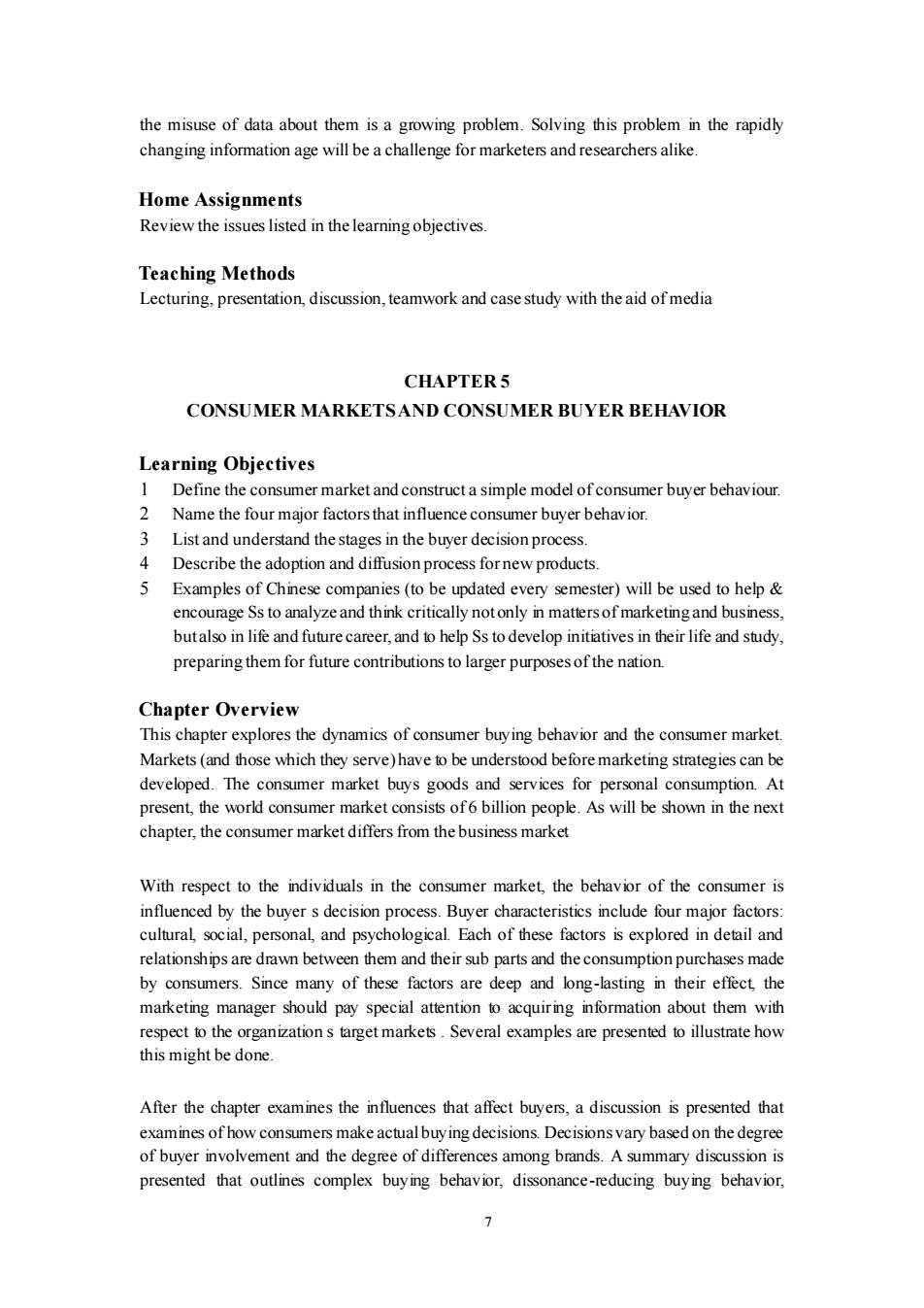
the misuse of data about them is a growing problem.Solving this problem in the rapidly changing information age will be a challenge for marketers and researchers alike Home Assignments Review the issues listed in the learning objectives Teaching Methods Lecturing.presentation,discussion,teamwork and case study with the aid ofmedia CONSUMER MARKETSAND CONSUMER BUYER BEHAVIOR Learning Objectives 1 Define the consumer market and construct a simple model ofconsumer buyer behaviour. 2 Name the four major factors that influence consumer buyer behavior. List and understand thestagesin the buyer decision process Describe the adoption and diffusion process for new products. 5 Examples of Chinese companies(to be updated every semester)will be used to help& encourage Ss to analyze and think critically notonly in mattersof marketingand business. preparing them for r future contributions to larger purposes of the nation Chapter Overview This chapter explores the dynamics of consumer buving behavior and the consumer market Markets (and hose which they serve)have o be unde erstood before marketing be developed.The consume er marke et buys goods an services for pers consumption.At present,the world consumer market consists of6 billion people.As will be shown in the next chapter,the consumer market differs from the business market With respect to the individuals in the consumer market,the behavior of the consumer is influenced by the buver s decision process.Buver characteristics include four major factors clhrmlocialpesonalandpychobgealEachofhesefctorsscplorodndcailand rawn bet twe n an and the by consumers.Since many of these factors are deep and long-lasting in their effect,the marketing manager should pay special attention to acquiring information about them with respect to the organizations target markets.Several examples are presented to illustrate how this might be done. After the chapter examines the influences that affect buyers.a discussion is presented that examines of how consumers make actual buying decisions Decisions vary based on the degree of buver involvement and the degree of differences among brands.A summary discussion is presented that complex buying behavior diss ance-educing buying behavior. 7
7 the misuse of data about them is a growing problem. Solving this problem in the rapidly changing information age will be a challenge for marketers and researchers alike. Home Assignments Review the issues listed in the learning objectives. Teaching Methods Lecturing, presentation, discussion, teamwork and case study with the aid of media CHAPTER 5 CONSUMER MARKETS AND CONSUMER BUYER BEHAVIOR Learning Objectives 1 Define the consumer market and construct a simple model of consumer buyer behaviour. 2 Name the four major factors that influence consumer buyer behavior. 3 List and understand the stages in the buyer decision process. 4 Describe the adoption and diffusion process for new products. 5 Examples of Chinese companies (to be updated every semester) will be used to help & encourage Ss to analyze and think critically not only in matters of marketing and business, but also in life and future career, and to help Ss to develop initiatives in their life and study, preparing them for future contributions to larger purposes of the nation. Chapter Overview This chapter explores the dynamics of consumer buying behavior and the consumer market. Markets (and those which they serve) have to be understood before marketing strategies can be developed. The consumer market buys goods and services for personal consumption. At present, the world consumer market consists of 6 billion people. As will be shown in the next chapter, the consumer market differs from the business market With respect to the individuals in the consumer market, the behavior of the consumer is influenced by the buyer s decision process. Buyer characteristics include four major factors: cultural, social, personal, and psychological. Each of these factors is explored in detail and relationships are drawn between them and their sub parts and the consumption purchases made by consumers. Since many of these factors are deep and long-lasting in their effect, the marketing manager should pay special attention to acquiring information about them with respect to the organization s target markets . Several examples are presented to illustrate how this might be done. After the chapter examines the influences that affect buyers, a discussion is presented that examines of how consumers make actual buying decisions. Decisions vary based on the degree of buyer involvement and the degree of differences among brands. A summary discussion is presented that outlines complex buying behavior, dissonance-reducing buying behavior
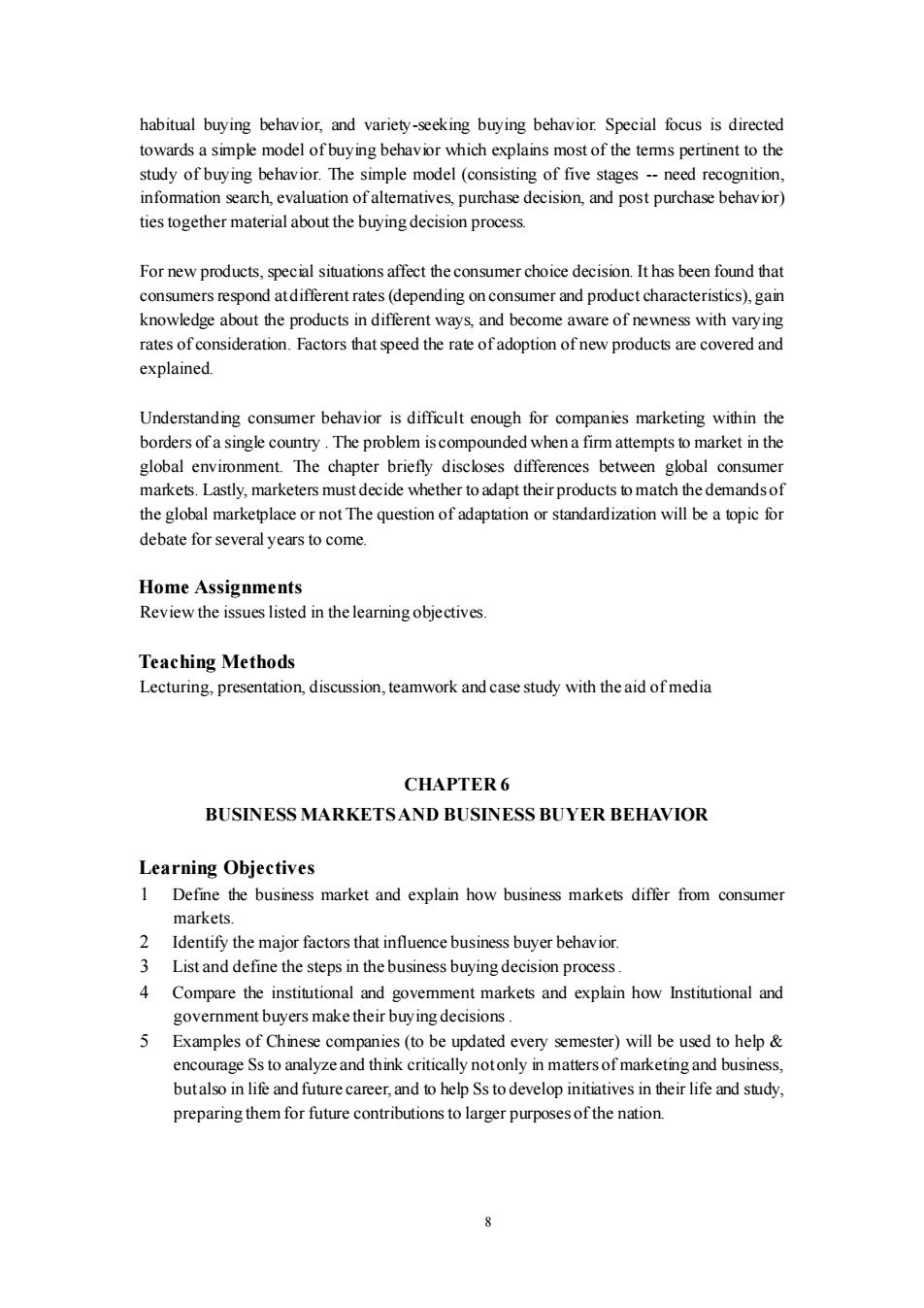
habitual buying behavior,and variety-seeking buying behavior.Special focus is directed o"ard本aSmp水.odloiuypemndadlecosigofieoHgeemspeimeat0 study of buying beha The --need recognitio infomation aluation of altematives purchase decison,and post purchas) ties together material about the buving decision process. For new products.ca situations affect decision It has been found that consumers respond atdifferent rates(dependingon sumer and product characteristics).gain knowledge about the products in different ways,and become aware of newness with varying rates of consideration.Factors that speed the rate ofadoption of new products are covered and explained. Understanding consumer behavior is difficult enough for companies marketing within the borders of a single country.The problem is compounded when a firm attempts to market in the global environment.The chapter briefly discloses differences between global consumer markets.Lastly,marketers must decide whether to adapt their products tomatch the demandsof the global marketplace or not The question of adaptation or standardization will be a topic for debate for several years to come. Home Assignments Review the issucs listed in thelearningobjectives. Teaching Methods Lecturing.presentation.discussion.teamwork and case study with the aid of media CHAPTER6 BUSINESS MARKETSAND BUSINESS BUYER BEHAVIOR Learning Objectives 1 Define the business market and explain how business markets differ from consumer markets 2 Identify the major factors that influence business buyer behavior. 3 List and define the steps in the business buying decision process. 4 Compare the institutional and gove men t markets and explain how Institutional and governn ment buyers make their buying decisions 5 Examples of Chinese companies(to be updated every semester)will be used to help& encourage Ss to analyze and think critically notonly in matters of marketing and business, butalso in life and futurecareer,and to help Ss to develop initiatives in their life and study, preparing them for future contributions to larger purposesof the nation
8 habitual buying behavior, and variety-seeking buying behavior. Special focus is directed towards a simple model of buying behavior which explains most of the terms pertinent to the study of buying behavior. The simple model (consisting of five stages -- need recognition, information search, evaluation of alternatives, purchase decision, and post purchase behavior) ties together material about the buying decision process. For new products, special situations affect the consumer choice decision. It has been found that consumers respond at different rates (depending on consumer and product characteristics), gain knowledge about the products in different ways, and become aware of newness with varying rates of consideration. Factors that speed the rate of adoption of new products are covered and explained. Understanding consumer behavior is difficult enough for companies marketing within the borders of a single country . The problem is compounded when a firm attempts to market in the global environment. The chapter briefly discloses differences between global consumer markets. Lastly, marketers must decide whether to adapt their products to match the demands of the global marketplace or not The question of adaptation or standardization will be a topic for debate for several years to come. Home Assignments Review the issues listed in the learning objectives. Teaching Methods Lecturing, presentation, discussion, teamwork and case study with the aid of media CHAPTER 6 BUSINESS MARKETS AND BUSINESS BUYER BEHAVIOR Learning Objectives 1 Define the business market and explain how business markets differ from consumer markets. 2 Identify the major factors that influence business buyer behavior. 3 List and define the steps in the business buying decision process . 4 Compare the institutional and government markets and explain how Institutional and government buyers make their buying decisions . 5 Examples of Chinese companies (to be updated every semester) will be used to help & encourage Ss to analyze and think critically not only in matters of marketing and business, but also in life and future career, and to help Ss to develop initiatives in their life and study, preparing them for future contributions to larger purposes of the nation
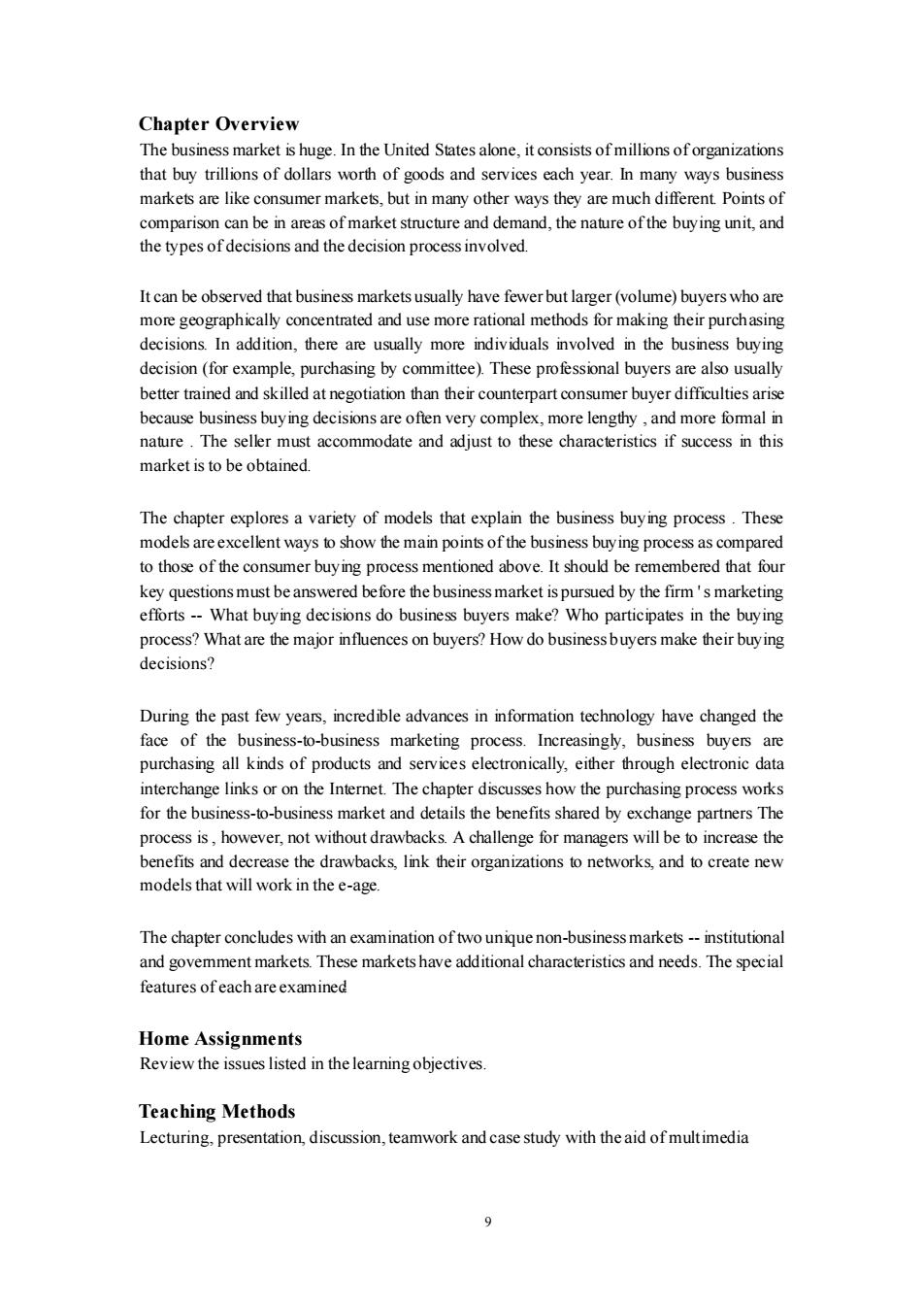
Chapter Overview The business market is huge Inthe United,of that buy trillions of dollars worth of goods and services each year.In many ways business markets are like consumer markets.but in many other ways they are much different Points of comparison can be in areas of market structure and demand,the nature ofthe buying unit,and the types of decisions and the decision process involved. It can be observed that business markets usually have fewer but larger (volume)buyers who are more geographically concentrated and use more rational methods for making their purchasing decisions.In addition,there are usually more individuals involved in the business buying decision (for example purchasing by committee)These professional buvers are also usuall use busine buying decisions are often very complex,more lengthy,and more fommal in nature.The seller must accommodate and adjust to these characteristics if success in this market is to be obtained. The chapter explores a variety of models that explain the business buying process.These models are excellent ways to show the main points of the business buving process as compared to those of the consumer buying process mentioned above.It shoul be remembered that four kequetions mt be answerd befre the business market is pursued by the firmsmarketing .What hir mg dec do buyin decisions? During the past few years.incredible advances in information technology have changed the face of the business-to-business marketing process.Increasingly,business buyers are purchasing all kinds of products and services electronically.either through electronic data interchange links or on the Internet The chapter discusses how the purchasing process works for the business-to-business market and details the benefits shared by exchange partners The ss is,ho ever,not without drawbacks Achallengeor managers crease the drawbacks.link their organizations to networks,and to create new models that will work in the e-age. unique non-business markets nstitution and govemment markets.These markets have additional characteristics and needs.The special features of each are examined Home Assignments Review the issues listed in the learning objectives Teaching Methods Lecturing.presentation,discussion,teamwork and case study with the aid 9
9 Chapter Overview The business market is huge. In the United States alone, it consists of millions of organizations that buy trillions of dollars worth of goods and services each year. In many ways business markets are like consumer markets, but in many other ways they are much different. Points of comparison can be in areas of market structure and demand, the nature of the buying unit, and the types of decisions and the decision process involved. It can be observed that business markets usually have fewer but larger (volume) buyers who are more geographically concentrated and use more rational methods for making their purchasing decisions. In addition, there are usually more individuals involved in the business buying decision (for example, purchasing by committee). These professional buyers are also usually better trained and skilled at negotiation than their counterpart consumer buyer difficulties arise because business buying decisions are often very complex, more lengthy , and more formal in nature . The seller must accommodate and adjust to these characteristics if success in this market is to be obtained. The chapter explores a variety of models that explain the business buying process . These models are excellent ways to show the main points of the business buying process as compared to those of the consumer buying process mentioned above. It should be remembered that four key questions must be answered before the business market is pursued by the firm ' s marketing efforts -- What buying decisions do business buyers make? Who participates in the buying process? What are the major influences on buyers? How do business buyers make their buying decisions? During the past few years, incredible advances in information technology have changed the face of the business-to-business marketing process. Increasingly, business buyers are purchasing all kinds of products and services electronically, either through electronic data interchange links or on the Internet. The chapter discusses how the purchasing process works for the business-to-business market and details the benefits shared by exchange partners The process is , however, not without drawbacks. A challenge for managers will be to increase the benefits and decrease the drawbacks, link their organizations to networks, and to create new models that will work in the e-age. The chapter concludes with an examination of two unique non-business markets -- institutional and government markets. These markets have additional characteristics and needs. The special features of each are examined Home Assignments Review the issues listed in the learning objectives. Teaching Methods Lecturing, presentation, discussion, teamwork and case study with the aid of multimedia

CHAPTER7 MARKET SEGMENTATION,TARGETING, AND POSITIONING FOR COMPETITIVEADVANTAGE Learning Objectives 1 Define the three steps of target marketing:market segmentation.market targeting.and market positioning. 2 List and discuss the major levels of market segmentation and bases for segmenting consumer and business markets. Explain how companies identify attractive market segmentsand choose a market coverage strategy 4 Discuss how companies position their products for maximum competitive advantage in the marketplace. Examples of Chinese companies (to be updated every semester)will be used to help& e and think and bu preparing them for future contributions to larger purposes of the nation Chapter Overview Sellers can take thre ap a market.Mas marketing is the first option.Under his approach the market kes a decision to mass-produce and mass-distribute one product an attempt to attract all kinds of buyers (1.e.,no market segmentation).The second option is segment marketing.Under this approach the marketer chooses to produce two or more market offers differentiated in style.features.quality.or sizes.designed to offer variety to the market and to set the sellers rt fo .In ast,th e ethods pursued:however,w on in the ketplace, he m become the option of choice by most fims.Under this third approach,the marketers decision is to identify the different groups that make up a market and to develop products and marketing mixes for selected target markets.Under a newly forming fourth approach.the fimm uses micro-marketing to tailor products and marketing programs to suit the tastes of specific ndividuals an ns(i.ethe practiceofcomplete segmentation) The chapter emphasizes the key steps in target marketing:market segmentation,market targeting.and market positioning.Market segmentation provides a method to divide or egment the market w segments (usir rent m sed at length in the chapter)that can be better reached with the resources of the marketer.Market targeting examines each of the designated segment s attractiveness and chooses one or more that match the marketing desires and objectives of the organization Home Assignments Review the issues listed in the learning objectives
10 CHAPTER 7 MARKET SEGMENTATION, TARGETING, AND POSITIONING FOR COMPETITIVE ADVANTAGE Learning Objectives 1 Define the three steps of target marketing: market segmentation, market targeting, and market positioning. 2 List and discuss the major levels of market segmentation and bases for segmenting consumer and business markets. 3 Explain how companies identify attractive market segments and choose a market coverage strategy 4 Discuss how companies position their products for maximum competitive advantage in the marketplace. 5 Examples of Chinese companies (to be updated every semester) will be used to help & encourage Ss to analyze and think critically not only in matters of marketing and business, but also in life and future career, and to help Ss to develop initiatives in their life and study, preparing them for future contributions to larger purposes of the nation. Chapter Overview Sellers can take three approaches to a market. Mass marketing is the first option. Under this approach the marketer makes a decision to mass-produce and mass-distribute one product and attempt to attract all kinds of buyers (i. e., no market segmentation). The second option is segment marketing. Under this approach the marketer chooses to produce two or more market offers differentiated in style, features, quality, or sizes, designed to offer variety to the market and to set the seller’s apart from competitor’s products. In the past, these methods were often pursued; however, with increasing fragmentation in the marketplace , niche marketing now has become the option of choice by most firms. Under this third approach, the marketer s decision is to identify the different groups that make up a market and to develop products and marketing mixes for selected target markets. Under a newly forming fourth approach, the firm uses micro-marketing to tailor products and marketing programs to suit the tastes of specific individuals and locations (i. e., the practice of complete segmentation). The chapter emphasizes the key steps in target marketing: market segmentation, market targeting, and market positioning. Market segmentation provides a method to divide or segment the market into narrow segments (using a variety of different meaningful variables -- these variables or bases are discussed at length in the chapter) that can be better reached with the resources of the marketer. Market targeting examines each of the designated segment s attractiveness and chooses one or more that match the marketing desires and objectives of the organization. Home Assignments Review the issues listed in the learning objectives